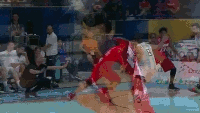vini_vidi_vici wrote:RealRapsFan wrote:vini_vidi_vici wrote:
But what im saying is you can be a great REB, and what it doesnt account for is how much hes giving up that could lead to the loss, again something im unwilling to delve into, I dont have the time or effort for that.
Ex: JV has a 18.5 REB%, perhaps OPPs (and im not saying they do, just usuing the stats/this discussion as anecdotal evidence) are REB at 20.5 REB%.
Like you said it could be teammates, but I think JV has some blame, and maybe in the later in the week ill dig and see what I can come up with.
but,
assuming all else is equal, that loss would/should be reflected in his reb% to... when the opposition gets more rebounds while I'm on the floor, my reb% will drop aswell (as both an individuals reb% and team reb% while said player is on the floor, happen while said player is on the floor).
So it still comes back to the team doing something different (in some fashion) making the situation unequal, and as such reflecting in JV's ireb%.
Is that true?
So lets clarify, iREB% is REBs based on availability while ___ is on court. Where does the loss come individually should say AD/JV always be on the floor at the same against each other and JV gets 18.1% of the available REBs and AD gets 20.5 REB%?
Maybe thats where im missing it.
its has to be true. You aren't 'available' for rebounds while on the bench. So an individuals reb% will be unchanged while on the bench. The only time it can change is while on the floor.
And if said player is giving up rebounds to the opposition (by, say, not boxing out), then his reb% will go down (as he is not getting rebounds, and the oppositions is)
Where does the loss come individually should say AD/JV always be on the floor at the same against each other and JV gets 18.1% of the available REBs and AD gets 20.5 REB%?
I'm not entirely sure what you mean here, so forgive me if I'm misunderstanding the question. If JV gets 18% of available rebounds and AD 20.5%, there is a gap of 61.5% of available rebounds explained by everyone else on the floor (on both teams).
Now, if, on the next rebound, AD gets the rebound we'll see 2 things happen simultaneously - JV's rebound % will drop (since he is getting less available rebounds) AND the teams rebound % while he is on the floor will drop (as the team is getting less available rebounds).
You can't be a good rebounder (statistically speaking) while also simultaneously giving up rebounds to the opposition (unless you are boxing out your teammates I guess

)
As such (assuming all else is equal),
- JV not doing something which causes the opposition to rebound more (ie. not boxing out AD) means that he'll have a worse reb% and the team will have a worse reb% while he's on the floor.
- If JV is getting the rebound himself, that means he'll have a better reb% and the team % while he's on the floor will also go up
- If JV is not getting the rebound, but helping others on the team to do so (boxing out) his reb% will drop, but the team's rebound% while he's on the floor will go up. (ie. the Amir effect)
But what he can't do, is rebound the ball while also causing the team's rebound % while he is on the floor to go down. He would literally have to rebound, and have his team not rebound, simultaneously, for that to happen. Which is impossible (its only one or the other).
If he rebounded, then so did the team.
The confusion, I think, is here - If he doesn't rebound, the team still can. So a player can see a drop in reb% while their team's rebounding improves (again, your Amir discussion point). But what they can't see is the inverse - a player rebounds, while also seeing the team's drop (since he, and therefore the team, got the rebound). In order for that to happen, it has to because things are no longer equal (ie. his team is no longer rebounding at their same rate).
So, to simplify (hopefully):
1)in order to see an
increase in team's rebounds while a player is on the floor, a player can either:
i) rebound himself (which means his reb% goes up)
ii) not rebound but have a teammate rebound (which means his reb% goes down)
2)in order to see a
decrease in the team's rebounds while a player is on the floor decrease, a player can:
i) not rebound (which means his reb% goes down) AND his teammates not rebound (which won't change his reb%),
Therefore, if JV is rebounding , but the team's rebounds are dropping while he is on the floor, it has to be that his teammates are not rebounding at the same rate. But that doesn't mean someone like Amir can't rebound less while also helping teammates.
Optimism Bias is the tendency of individuals to underestimate the likelihood they will experience adverse events. Optimistic bias cannot be reduced, and by trying to reduce the optimistic bias the end result was generally even more optimistically biased

















